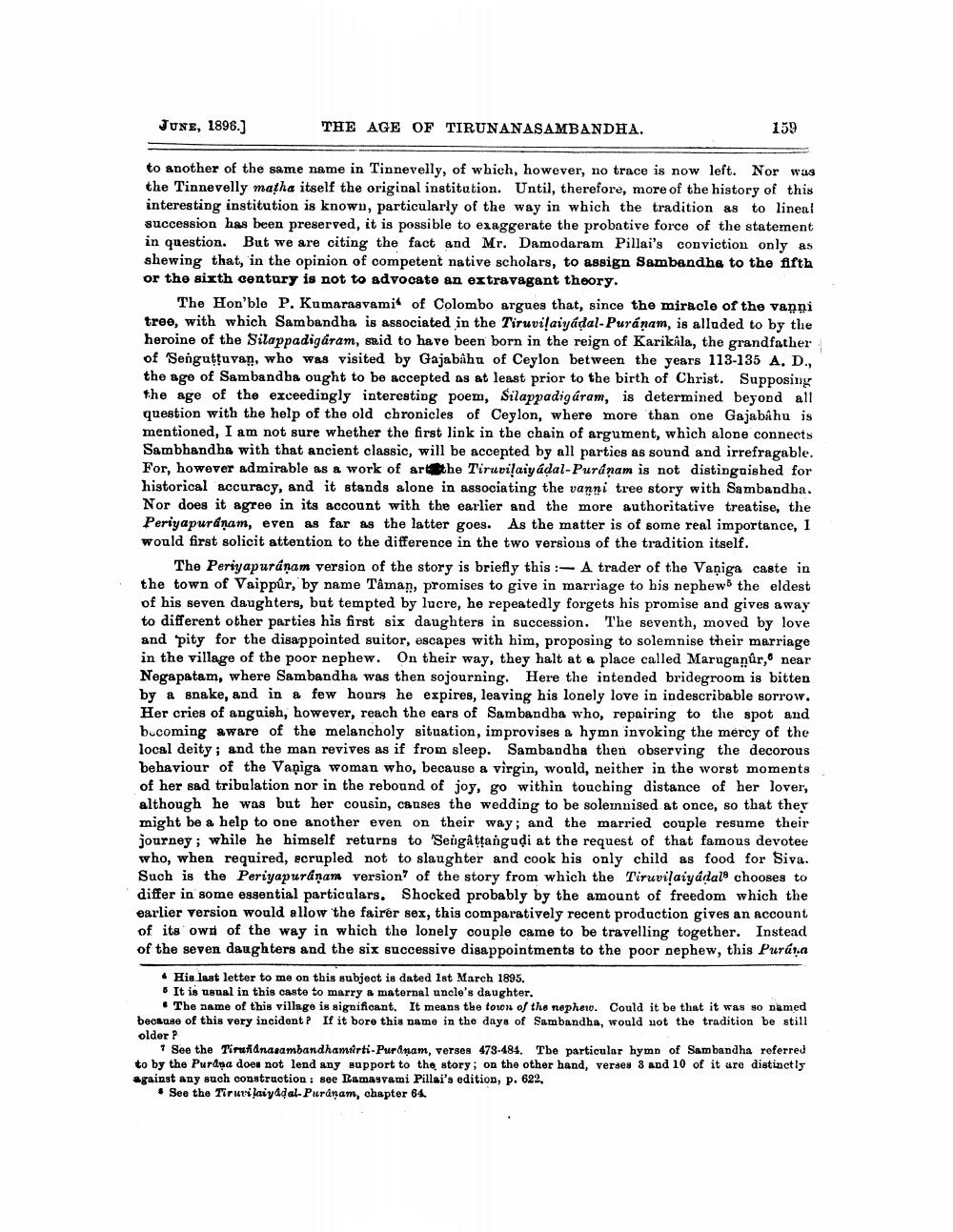________________
JUNE, 1896.)
THE AGE OF TIRUNANASAMBANDHA.
159
to another of the same name in Tinnevelly, of which, however, no trace is now left. Nor was the Tinnevelly matha itself the original institution. Until, therefore, more of the history of this interesting institution is known, particularly of the way in which the tradition as to lineal succession has been preserved, it is possible to exaggerate the probative force of the statement in question. But we are citing the fact and Mr. Damodaram Pillai's conviction only as shewing that, in the opinion of competent native scholars, to assign Sambandha to the fifth or the sixth century is not to advocate an extravagant theory.
The Hon'blo P. Kumarasvamit of Colombo argues that, since the miracle of the vanni tree, with which Sambandha is associated in the Tiruvilaiyádal-Puránam, is alluded to by the heroine of the Silappadigaram, said to have been born in the reign of Karikala, the grandfather of Senguttuvan, who was visited by Gajabahu of Ceylon between the years 113-135 A, D., the age of Sambandha ought to be accepted as at least prior to the birth of Christ. Supposing the age of the exceedingly interesting poem, Silappadigáram, is determined beyond all question with the help of the old chronicles of Ceylon, where more than one Gajabâhu is mentioned, I am not sure whether the first link in the chain of argument, which alone connects Sambhandhs with that ancient classic, will be accepted by all parties as sound and irrefragable. For, however admirable as a work of art the Tiruvilaiyádal-Puranam is not distinguished for historical accuracy, and it stands alone in associating the vanni tree story with Sambandha. Nor does it agree in its account with the earlier and the more authoritative treatise, the Periyapuranam, even as far as the latter goes. As the matter is of some real importance, 1 would first solicit attention to the difference in the two versions of the tradition itself.
The Periyapuranam version of the story is briefly this:-- A trader of the Vaniga caste in the town of Vaippûr, by name Taman, promises to give in marriage to his nephew the eldest of his seven daughters, but tempted by lucre, he repeatedly forgets his promise and gives away to different other parties his first six daughters in succession. The seventh, moved by love and pity for the disappointed suitor, escapes with him, proposing to solemnise their marriage in the village of the poor nephew. On their way, they halt at a place called Maruganûr, near Negapatam, where Sambandha was then sojourning. Here the intended bridegroom is bitten by a snake, and in a few hours he expires, leaving his lonely love in indescribable sorrow. Her cries of anguish, however, reach the ears of Sambandha who, repairing to the spot and becoming aware of the melancholy situation, improvises a hymn invoking the mercy of the local deity; and the man revives as if from sleep. Sambandha then observing the decorous behaviour of the Vaniga woman who, because a virgin, would, neither in the worst moments of her sad tribulation nor in the rebound of joy, go within touching distance of her lover, although he was but her cousin, causes the wedding to be solemnised at once, so that the might be a help to one another even on their way; and the married couple resume their journey; while he himself returns to 'Seigâttangudi at the request of that famous devotee who, when required, ecrupled not to slaughter and cook his only child as food for Siva. Such is the Periyapuranam version of the story from which the Tiruvilaiyadal® chooses to differ in some essential particulars. Shocked probably by the amount of freedom which the earlier version would allow the fairer sex, this comparatively recent production gives an account of its own of the way in which the lonely couple came to be travelling together. Instead of the seven daughters and the six successive disappointments to the poor nephew, this Purára
• His last letter to me on this subject is dated 1st March 1895. • It is usual in this casto to marry & maternal uncle's daughter.
. The name of this village is significant. It means the town of the nephew. Could it be that it was so named boonuse of this very incident? If it bore this name in the days of Sambandha, would not the tradition be still older P
+ See the Tiruranasambandhamirti-Puranam, verses 479-484. The particular hymn of Sambandha referred to by the Purana does not lend any support to the story, on the other hand, verses 3 and 10 of it are distinctly against any such construction : see Ramasvami Pillai's edition, p. 622
. See the Tiruvilaiyadal-Purinam, chapter 64.




